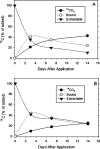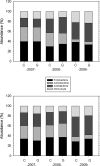Glyphosate effects on plant mineral nutrition, crop rhizosphere microbiota, and plant disease in glyphosate-resistant crops
- PMID: 23013354
- PMCID: PMC3479986
- DOI: 10.1021/jf302436u
Glyphosate effects on plant mineral nutrition, crop rhizosphere microbiota, and plant disease in glyphosate-resistant crops
Erratum in
- J Agric Food Chem. 2013 Dec 26;61(51):12745
Abstract
Claims have been made recently that glyphosate-resistant (GR) crops sometimes have mineral deficiencies and increased plant disease. This review evaluates the literature that is germane to these claims. Our conclusions are: (1) although there is conflicting literature on the effects of glyphosate on mineral nutrition on GR crops, most of the literature indicates that mineral nutrition in GR crops is not affected by either the GR trait or by application of glyphosate; (2) most of the available data support the view that neither the GR transgenes nor glyphosate use in GR crops increases crop disease; and (3) yield data on GR crops do not support the hypotheses that there are substantive mineral nutrition or disease problems that are specific to GR crops.
Figures









References
-
- Fernandez-Cornejo J.; McBride W. D.. The Adoption of Bioengineered Crops; U.S. Department of Agriculture, Economic Research Service: Washington D.C., 2002; . Agricultural Economic Report No. 810, May, 2002.
-
- Heap I.International Survey of Herbicide Resistant Weeds (http://www.weedscience.org/in.asp, accessed September 12, 2012).
-
- Johnson W. G.; Davis V. M.; Kruger G. R.; Weller S. C. Influence of glyphosate-resistant cropping systems on weed species shifts and glyphosate-resistant weed populations. Eur. J. Agron. 2009, 31, 162–172.
-
- Duke S. O.; Baerson S. R.; Rimando A. M.. Herbicides: Glyphosate. In Encyclopedia of Agrochemicals; Plimmer J. R., Gammon D. W., Ragsdale N. N., Eds.; John Wiley & Sons: New York, 2003. (http://onlinelibrary.wiley.com/book/10.1002/047126363X, accessed September 12, 2012).
-
- Duke S. O.; Powles S. B. Glyphosate: A once in a century herbicide. Pest Manag. Sci. 2008, 64, 319–325. - PubMed
Publication types
MeSH terms
Substances
LinkOut - more resources
Full Text Sources
Medical

